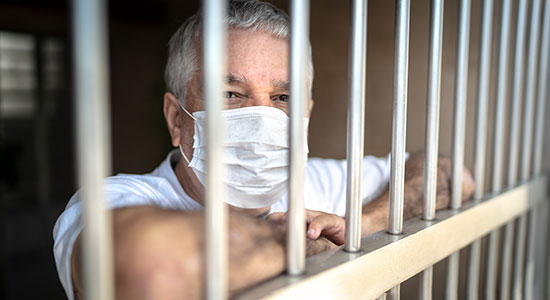
Nov. 18, 2020 – In March, the first federal inmate died of COVID-19. As of last week, 135 federal inmates have died of COVID-19, about 2,500 current inmates are positive, and more than 17,000 inmates have contracted COVID-19 but recovered.1
Amidst the pandemic, lawyer groups have partnered to create a Compassionate Release Clearinghouse, a national pro bono effort to secure compassionate releases for vulnerable federal prisoners. What has resulted is a wave of inmate requests.
A number of federal district courts, including district courts in Wisconsin, have ruled that the petitioner was eligible for a compassionate release, under the federal compassionate release statute, while other courts have issued denials.
State inmates have a much harder procedural road to obtain a compassionate release. According to Marquette University Law School Prof. Michael O’Hear, who teaches criminal law, compassionate releases are historically rare in Wisconsin.
Federal Compassionate Release Statute
A federal law enacted in 2018, the First Step Act, opened the door for more federal inmates to directly petition federal district courts for a compassionate release under 18 U.S.C. section 3582(c)(1)(A).
 Joe Forward, Saint Louis Univ. School of Law 2010, is a legal writer for the State Bar of Wisconsin, Madison. He can be reached by email or by phone at (608) 250-6161.
Joe Forward, Saint Louis Univ. School of Law 2010, is a legal writer for the State Bar of Wisconsin, Madison. He can be reached by email or by phone at (608) 250-6161.
That statute allows courts to reduce prison terms if the court finds “extraordinary and compelling reasons warrant such a reduction” or the defendant is at least 70 years of age, has served at least 30 years in prison, and the defendant is not deemed a danger.
Under a prior version of the law, only the director of the bureau of prisons (BOP) could petition for a prisoner’s compassionate release under 18 U.S.C. section 3582(c)(1)(A).
But such petitions were rare. Between 2006 and 2011, only 24 inmates were released each year through the BOP’s compassionate release program.2
The First Step Act, signed by President Donald Trump as part of a broader correctional reform package intended to reduce the size of the federal prison population, also allows prisoners to directly petition for a compassionate release if the BOP fails to do so.
The defendant may bring the petition after exhausting “all administrative rights to appeal a failure of the [BOP] to bring a motion on the defendant's behalf or the lapse of 30 days from the receipt of such a request by the warden of the defendant's facility.”3
“The 30-day rule significantly streamlines what had previously sometimes been a very slow-moving bureaucratic process,” Prof. O’Hear said.
As one article reiterates, social distancing is impossible in prisons. “Protective measures publicized by government leaders and the press, such as avoiding large groups, heightened sanitation practices, and wearing protective gear, are impossible goals for people locked in jails and prisons,” wrote attorney Elizabeth Blackwood.4
Blackwood is the project director for the National Association of Criminal Defense Lawyer’s (NACDL) First Step Act Resource Center. NACDL partnered with the Families Against Mandatory Minimums and the Washington Lawyers’ Committee for Civil Rights and Urban Affairs to create the pro bono Compassionate Release Clearinghouse.
In the year of COVID-19, federal prisoners have filed thousands of petitions for compassionate release – with the help of pro bono attorneys – and many of the petitions have already been granted. However, many others have been denied.
Facts and Circumstances
In U.S. v. Morgan, for instance, the U.S. District Court for the Eastern District of Wisconsin granted petitioner Levell Morgan’s petition for compassionate release.
Morgan pleaded guilty to intent to distribute marijuana (about 16 grams) and crack cocaine (about 20 grams), and received a 12-year federal prison sentence.
However, he did not have a history of violence and prior drug dealing offenses, considered in determining his sentence, involved modest amounts of drugs.
Morgan, who had served 10 years of his 12-year sentence, petitioned for a compassionate release after exhausting his administrative rights. District Court Judge Lynn Adelman granted Morgan’s petition, reducing his sentence to time served.
“In the context of the COVID-19 pandemic, courts have found that modification may be warranted if the prisoner demonstrates that he is particularly vulnerable to the virus based on his age, health status, or other specific circumstances; on the other hand, courts have tended to deny compassionate release requests based on general concerns about possible exposure in prison,” wrote Judge Adelman.
Morgan suffered from morbid obesity and hypertension, which increased his risk of severe illness from COVID-19, Judge Adelman noted. In addition, Morgan’s prison facility, at the time, had nine positive cases among inmates and staff members.
“While several other facilities have experienced greater outbreaks, the presence of the virus in defendant's facility indicates that the risk of infection is more than theoretical,” wrote Judge Adelman, noting Morgan was doing a drug rehabilitation program and had a solid release plan. “Releasing him now will not pose a danger to the public.”
The same day that Judge Adelman granted Morgan’s request, he denied a compassionate release request by Adam Meyer, who pleaded guilty to wire fraud, extortion, and travel to commit a crime of violence. The case stemmed from a sports gambling scheme that bilked a wealthy Wisconsin business man of millions of dollars.
Meyer received an eight-year prison sentence and is set for release in 2022. Meyer, serving time in Florida, argued that he is at risk of severe illness from COVID-19 because of pre-diabetes, obesity, hypertension, and a heart condition.
But Judge Adelman thought the medical evidence was shaky. “[W]hile defendant's medical history includes conditions that might in some cases support compassionate release, he fails to present specific evidence demonstrating that the risk he faces is extraordinary and the need for release compelling,” Judge Adelman wrote.
Judge Adelman also noted that Meyer engaged in a years-long scheme, caused millions of dollars in losses through coercion and intimidation, and committed his offense while on federal probation for other gambling fraud schemes.
“Given these circumstances, a reduced sentence would fail to provide just punishment, promote respect for the law, protect the public, and deter future crimes,” Adelman wrote.
State Compassionate Release
While the First Step Act allows federal prisoners to petition courts directly, Wisconsin’s compassionate release statute involves more procedural steps to obtain relief, meaning Wisconsin’s elderly and sick inmates are not likely to escape COVID-19 any time soon.
Wisconsin’s state prison and jail inmate population is almost 21,000. As of last week, nearly 6,000 Wisconsin inmates have tested positive for COVID-19 since March, with 10 deaths, according to the Wisconsin Department of Corrections. Currently, there are about 1,400 active positive cases among the state inmate population.
Cases spiked dramatically starting in September. As of last week, more than 1,300 correctional staff employees have tested positive for COVID-19 since March. Currently, there are about 330 active positive cases among correctional staff employees.
Under Wis. Stat. section 302.113(9g), an inmate can obtain a compassionate release if he or she “has an extraordinary health condition,” defined as “a condition afflicting a person, such as advanced age, infirmity or disability of the person or a need for medical treatment or services not available within a correctional institution.”
Unlike federal law, which allows an individual to petition for compassionate release directly to the federal district court, a state inmate must go through numerous steps:
-
Submit a petition to the program review committee at the correctional institution in which the inmate is confined requesting a sentence modification with affidavits from two physicians;
-
If the program review committee approves the petition, the petition is referred to the Department of Corrections to notify the department of the committee’s approval;
-
The department then refers the petition to the sentencing court to conduct a hearing on the petition;
-
The sentencing court then conducts a hearing to determine whether the public interest would be served by a sentence modification. At the hearing, the inmate has the burden of proving by the greater weight of the credible evidence that a modification of the sentence would serve the public interest;
-
If the court determines that a modification of the bifurcated sentence is allowable, the court can reduce the confinement term of the sentence and release the inmate to extended supervision within 30 days or lengthen the term of extended supervision so that the total length of the bifurcated sentence originally imposed does not change.
Wisconsin attorney Nicole Murphy examined the history of Wisconsin’s compassionate release statute in a 2012 article, published in the Marquette Law Review.5
Murphy, as a law student, noted that in 2009, the Wisconsin Legislature amended the statute’s compassionate release statute to expand the pool of eligible candidates amidst mass incarceration in Wisconsin, which has both fiscal and social consequences.
“Compassionate release, also identified as medical parole or medical furlough, became popular among state governments as a fiscally attractive alternative in the last decade to reduce strain on state correction budgets,” Murphy wrote.
“In Wisconsin, legislators maintained that increasing early release eligibility for ill and elderly inmates would help alleviate a portion of the financial pressure on corrections institutions across the state and, thus, reduce the state budget.”
The 2009 amendments allowed a state inmate to directly petition an eight-person Earned Release Review Commission (ERRC), which was empowered to grant a compassionate release if a petitioner showed an “extraordinary health condition.”
The ERRC required affidavits from two physicians and would hold a hearing to determine “whether the public interest would be served by a modification of the inmate’s sentence.” The petitioner had the burden to demonstrate – by a greater weight of the credible evidence – that a sentence modification would be in the public’s best interest.
Between 2009 and 2011, 55 inmates petitioned the ERRC for a compassionate release and eight petitions were granted.6 The others were denied or the compassionate release statute changed again, in 2011, before ERRC could make a determination.7
The 2009 amendments were part of a larger package of early release legislation. However, in 2011, the Wisconsin Legislature repealed the early release legislation, including the compassionate release amendments, abolishing the ERRC.
Federal vs. State Compassionate Release
Wisconsin’s current compassionate release statute requires inmates to get approval from a program review committee before the sentencing court hears the petition, while federal inmates can petition courts directly with no corrections gatekeeper.
However, Prof. O’Hear noted differences in the state and federal sentencing. “In Wisconsin, the Department of Corrections stands as a barrier to inmates presenting their petitions to the sentencing court, but it is not clear how receptive sentencing courts would be to these petitions even if more of them could get to that stage,” he said.
“For the most part, the inmates seeking compassionate release in Wisconsin received prison terms that were selected by the sentencing court through an exercise of discretion,” Prof. O’Hear said. “By contrast, a larger share of federal sentences result from harsh mandatory minimums. Additionally, many of the older inmates who are now seeking federal compassionate release were sentenced back when the federal sentencing guidelines were more binding on judges.”
As a result, Prof. O’Hear said, in many cases, the federal compassionate release petitions are seeking changes to prison terms that the sentencing court was not especially keen to impose in the first place. “It might be expected, then, that federal judges would tend to be more receptive to compassionate release petitions than state.”
Endnotes
1 Federal Bureau of Prisons, www.bop.gov/coronavirus/.
2 See Dep't of Justice, Office of the Inspector General, The Federal Bureau of Prisons' Compassionate Release Program (April 2013), at 1.
3 Elizabeth A. Blackwood, Compassionate Release, Champion, April 2020, at 51.
4 Id.
5 Nicole M. Murphy, Dying to Be Free: An Analysis of Wisconsin's Restructured Compassionate Release Statute, 95 Marq. L. Rev. 1679 (2012).
6 Id. at 1709.
7 Id. at 1709.
